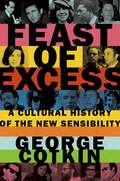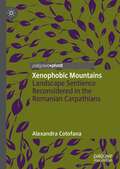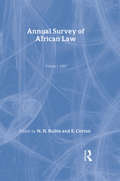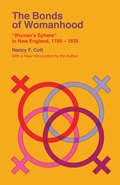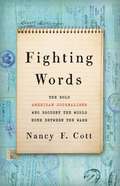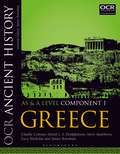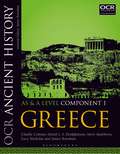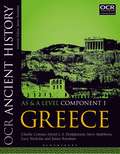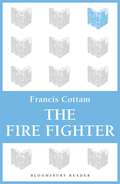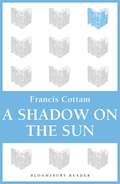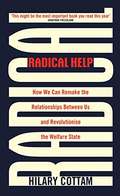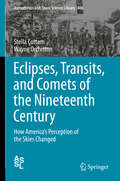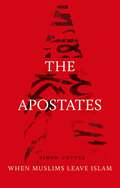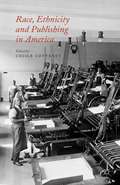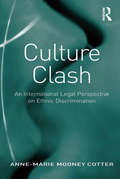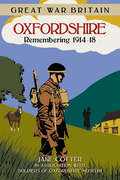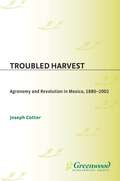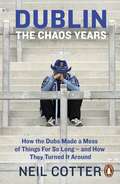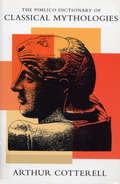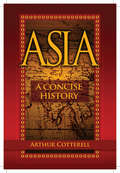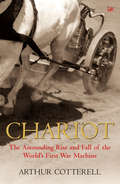- Table View
- List View
Feast of Excess: A Cultural History of the New Sensibility
by George CotkinIn 1952, John Cage shocked audiences with 4'33", his compositional ode to the ironic power of silence. From Cage's minimalism to Chris Burden's radical performance art two decades later (in one piece he had himself shot), the post-war American avant-garde shattered the divide between low and high art, between artist and audience. They changed the cultural landscape. Feast of Excess is an engaging and accessible portrait of "The New Sensibility," as it was named by Susan Sontag in 1965. The New Sensibility sought to push culture in extreme directions: either towards stark minimalism or gaudy maximalism. Through vignette profiles of prominent figures-John Cage, Patricia Highsmith, Allen Ginsberg, Andy Warhol, Anne Sexton, John Coltrane, Bob Dylan, Erica Jong, and Thomas Pynchon, to name a few-George Cotkin presents their bold, headline-grabbing performances and places them within the historical moment. This inventive and jaunty narrative captures the excitement of liberation in American culture. The roots of this release, as Cotkin demonstrates, began in the 1950s, boomed in the 1960s, and became the cultural norm by the 1970s. More than a detailed immersion in the history of cultural extremism, Feast of Excess raises provocative questions for our present-day culture.
Feast of Excess: A Cultural History of the New Sensibility
by George CotkinIn 1952, John Cage shocked audiences with 4'33", his compositional ode to the ironic power of silence. From Cage's minimalism to Chris Burden's radical performance art two decades later (in one piece he had himself shot), the post-war American avant-garde shattered the divide between low and high art, between artist and audience. They changed the cultural landscape. Feast of Excess is an engaging and accessible portrait of "The New Sensibility," as it was named by Susan Sontag in 1965. The New Sensibility sought to push culture in extreme directions: either towards stark minimalism or gaudy maximalism. Through vignette profiles of prominent figures-John Cage, Patricia Highsmith, Allen Ginsberg, Andy Warhol, Anne Sexton, John Coltrane, Bob Dylan, Erica Jong, and Thomas Pynchon, to name a few-George Cotkin presents their bold, headline-grabbing performances and places them within the historical moment. This inventive and jaunty narrative captures the excitement of liberation in American culture. The roots of this release, as Cotkin demonstrates, began in the 1950s, boomed in the 1960s, and became the cultural norm by the 1970s. More than a detailed immersion in the history of cultural extremism, Feast of Excess raises provocative questions for our present-day culture.
Xenophobic Mountains: Landscape Sentience Reconsidered in the Romanian Carpathians
by Alexandra CotofanaThis book, based on ethnographic research in Romania, traces the ontological red lines that form a world in which xenophobic landscapes are possible. The last couple hundred years in Romania’s history have been marked by change of political regimes, but this manuscript pays equal attention to an important continuity in Romania’s ontological world: its understanding of the landscape, and the relationship between Romanian people and their land. From political discourses to children’s books, to literature, and explanations found for everyday events, the book follows the ways in which the landscape of Romania has been understood as a sentient being imbued with willpower and ability to act on the world. The sentience specific to Romania’s landscape is characterized by xenophobia—a fear and distrust of ethno-religious others—that has been historically interpreted by Romanians as manifesting through acts of violence enacted by the landscape towards various groups of humans understood as dangerous to the country’s unity.The novelty of this book lies in the fact that it is an in-depth analysis of an ontological world in which sentient landscapes are de-romanticized and presented in their uncomfortable complexity. The concept of sentient xenophobic mountains can add a great deal to the current literature on the ontological turn and ontological multiplicities, by questioning binaries like colonized/colonizer, indigenous/colonial, sentient landscape/industrial superpower. Romania’s history makes it a good case study for this exercise, as the country has been at the margins of empires, both desired because of its natural resources and rejected because of the perceived inferiority of its people, both racialized and racist, both neoliberal and imagining absolute sovereignty.
Annual Survey of African Law Cb: Volume One : 1967
by Eugene Cotran Neville N. RubinThis is the first in a series of annual volumes which aim to review the principal legal developments that take place in the countries of sub-Saharan Africa. This series is intended to enable those who have an academic or professional interest in African law to keep abreast of changes in the various branches of the different legal systems of Africa.
The Bonds of Womanhood: "Woman's Sphere" in New England, 1780-1835 (Veritas Paperbacks)
by Nancy F. CottThis Veritas edition of Nancy Cott’s acclaimed study includes a new introduction by the author, situating the work for a new generation of readers. “Elegant and convincing. . . . Better than any other work available, The Bonds of Womanhood describes both the classic attitudes of the nineteenth century toward women and the opposition to the oppression of women in the historical context from which they grew.”—Willie Lee Rose, New York Review of Books “A lovely, gentle, scholarly, and valuable book.”—Doris Grumbach, New York Times Book Review
Fighting Words: The Bold American Journalists Who Brought the World Home Between the Wars
by Nancy F. CottFrom a Harvard historian, this riveting portrait of four trailblazing American journalists highlights the power of the press in the interwar period. In the fragile peace following the Great War, a surprising number of restless young Americans abandoned their homes and set out impulsively to see the changing world. In Fighting Words, Nancy F. Cott follows four who pursued global news -- from contested Palestine to revolutionary China, from Stalin's Moscow to Hitler's Berlin. As foreign correspondents, they became players in international politics and shaped Americans' awareness of critical interwar crises, the spreading menace of European fascism, and the likelihood of a new war -- while living romantic and sexual lives as modern and as hazardous as their journalism. An indelible portrayal of a tumultuous era with resonance for our own, Fighting Words is essential reading on the power of the press and the growth of an American sense of international responsibility.
OCR Ancient History AS and A Level Component 1: Greece
by Charlie Cottam David L. Hodgkinson Steve Matthews Lucy Nicholas James RenshawThis textbook is endorsed by OCR and supports the specification for AS and A-Level Ancient History (first teaching September 2017). It covers the whole of Component 1, both the compulsory Period Study and the three optional Depth Studies:Period Study: Relations between Greek states and between Greek and non-Greek states, 492–404 BC by Steve Matthews and James RenshawDepth Study: The Politics and Society of Sparta, 478–404 BC by Charlie CottamDepth Study: The Politics and Culture of Athens c. 460–399 BC by David L. S. Hodgkinson and James RenshawDepth Study: The Rise of Macedon, 359–323 BC by Lucy NicholasHow and why did a small group of city states defy the might of the Persian Empire? Why did the same city states subsequently descend into 60 years of conflict among themselves? Were Sparta and Athens very different? How did Alexander later redefine the Greek world?These are the sort of questions that you are required to consider for A-Level Ancient History. This book investigates how the birth of democracy and the defeat of Persia allowed a flourish of political and philosophical thought that subsequently defined western civilisation. It further explores the contrasts between Spartan and Athenian culture.The ideal preparation for the final examinations, all content is presented by experts and experienced teachers in a clear and accessible narrative. Ancient literary and visual sources are described and analysed, with supporting images. Helpful student features include study questions, further reading, and boxes focusing in on key people, events and terms. Practice questions and exam guidance prepare students for assessment.A Companion Website is available at www.bloomsbury.com/ anc-hist-as-a-level.
OCR Ancient History AS and A Level Component 1: Greece
by Charlie Cottam David L. Hodgkinson Steve Matthews Lucy Nicholas James RenshawThis textbook is endorsed by OCR and supports the specification for AS and A-Level Ancient History (first teaching September 2017). It covers the whole of Component 1, both the compulsory Period Study and the three optional Depth Studies:Period Study: Relations between Greek states and between Greek and non-Greek states, 492–404 BC by Steve Matthews and James RenshawDepth Study: The Politics and Society of Sparta, 478–404 BC by Charlie CottamDepth Study: The Politics and Culture of Athens c. 460–399 BC by David L. S. Hodgkinson and James RenshawDepth Study: The Rise of Macedon, 359–323 BC by Lucy NicholasHow and why did a small group of city states defy the might of the Persian Empire? Why did the same city states subsequently descend into 60 years of conflict among themselves? Were Sparta and Athens very different? How did Alexander later redefine the Greek world?These are the sort of questions that you are required to consider for A-Level Ancient History. This book investigates how the birth of democracy and the defeat of Persia allowed a flourish of political and philosophical thought that subsequently defined western civilisation. It further explores the contrasts between Spartan and Athenian culture.The ideal preparation for the final examinations, all content is presented by experts and experienced teachers in a clear and accessible narrative. Ancient literary and visual sources are described and analysed, with supporting images. Helpful student features include study questions, further reading, and boxes focusing in on key people, events and terms. Practice questions and exam guidance prepare students for assessment.A Companion Website is available at www.bloomsbury.com/ anc-hist-as-a-level.
OCR Ancient History As And A Level Component 1: Greece (PDF)
by Charlie Cottam David Hodgkinson Steve Matthews Lucy Nicholas James RenshawThis textbook is endorsed by OCR and supports the specification for AS and A-Level Ancient History (first teaching September 2017). It covers the whole of Component 1, both the compulsory Period Study and the three optional Depth Studies:Period Study: Relations between Greek states and between Greek and non-Greek states, 492-404 BC by Steve Matthews and James RenshawDepth Study: The Politics and Society of Sparta, 478-404 BC by Charlie CottamDepth Study: The Politics and Culture of Athens c. 460-399 BC by David L. S. Hodgkinson and James RenshawDepth Study: The Rise of Macedon, 359-323 BC by Lucy NicholasHow and why did a small group of city states defy the might of the Persian Empire? Why did the same city states subsequently descend into 60 years of conflict among themselves? Were Sparta and Athens very different? How did Alexander later redefine the Greek world?These are the sort of questions that you are required to consider for A-Level Ancient History. This book investigates how the birth of democracy and the defeat of Persia allowed a flourish of political and philosophical thought that subsequently defined western civilisation. It further explores the contrasts between Spartan and Athenian culture. The ideal preparation for the final examinations, all content is presented by experts and experienced teachers in a clear and accessible narrative. Ancient literary and visual sources are described and analysed, with supporting images. Helpful student features include study questions, further reading, and boxes focusing in on key people, events and terms. Practice questions and exam guidance prepare students for assessment. A Companion Website is available at www. bloomsbury. com/ anc-hist-as-a-level.
The Fire Fighter: A Novel Of War
by Francis CottamAutumn 1940. London is being firebombed, unable to strike back as the Luftwaffe drones overhead. Jack Finlay, a young man notorious for his ability to fight fires, is given the task of preventing five buildings vital to Britain's war effort from being engulfed by the flames.But resources are scarce and the mood is bleak, and Finlay himself suspicious about the real motive for his mission. And then he falls in love with a woman as unorthodox as he is: a wartime liaison as improbable as it is intense, dangerous because it makes him as vulnerable as the flames and plots twist around him.
A Shadow on the Sun
by Francis CottamFirst published in 2006, this is the story of Polish war exile Julia Smollen who has escaped the horrors of Nazi labour camp to forge a new life in California with her daughter, Natasha.It's an exciting time to be in America. With Sinatra and the ratpack dominating a golden Hollywood and the young Jack Kennedy emerging on the political scene, it's a time of optimism and opportunity. Under the protection of her former lover's great friend, Bill, Julia and her daughter thrive.Yet Natasha remains unaware of her true identity. She knows nothing of her father, the courageous German officer Martin Hamer, fatally wounded helping the then-pregnant Julia flee her occupied homeland.Julia cannot keep the truth hidden from her daughter forever. A sinister figure from the past has tracked them down, with his own dark, vengeful agenda...
Radical Help: How we can remake the relationships between us and revolutionise the welfare state
by Hilary CottamHow should we live: how should we care for one another; grow our capabilities to work, to learn, to love and fully realise our potential? This exciting and ambitious book shows how we can re-design the welfare state for this century. The welfare state was revolutionary: it lifted thousands out of poverty, provided decent homes, good education and security. But it is out of kilter now: an elaborate and expensive system of managing needs and risks. Today we face new challenges. Our resources have changed. Hilary Cottam takes us through five 'Experiments' to show us a new design. We start on a Swindon housing estate where families who have spent years revolving within our current welfare systems are supported to design their own way out. We spend time with young people who are helped to make new connections - with radical results. We turn to the question of good health care and then to the world of work and see what happens when people are given different tools to make change. Then we see those over sixty design a new and affordable system of support. At the heart of this way of working is human connection. Upending the current crisis of managing scarcity, we see instead that our capacities for the relationships that can make the changes are abundant. We must work with individuals, families and communities to grow the core capabilities we all need to flourish. Radical Help describes the principles behind the approach, the design process that makes the work possible and the challenges of transition. It is bold - and above all, practical. It is not a book of dreams. It is about concrete new ways of organising that already have been developing across Britain. Radical Help creates a new vision and a radically different approach that can take care of us once more, from cradle to grave.
Eclipses, Transits, and Comets of the Nineteenth Century: How America's Perception of the Skies Changed (Astrophysics and Space Science Library #406)
by Stella Cottam Wayne OrchistonWinner of the AAS 2019 Donald E. Osterbrock Book Prize for Historical AstronomyGrabbing the attention of poets, politicians and the general public alike, a series of spectacular astronomical events in the late 1800s galvanized Americans to take a greater interest in astronomy than ever before. At a time when the sciences were not yet as well established in the United States as they were in Europe, this public interest and support provided the growing scientific community in the United States with the platform they needed to advance the field of astronomy in the United States. Earlier in the 19th century comets, meteors and the discovery of the planet Neptune were all sources of inspiration to the general public. The specific events to be considered here are the total solar eclipses of 1868, 1869 and 1878 and the transits of Venus of 1874 and 1882. The available media responded to public interest as well as generating more interest. These events laid the groundwork that led to today's thriving network of American amateur astronomers and provide a fascinating look at earlier conceptions of the stars.
The Apostates: When Muslims Leave Islam
by Simon CotteeThe Apostates is the first major study of apostasy from Islam in the western secular context. Drawing on life-history interviews with ex-Muslims from the UK and Canada, Simon Cottee explores how and with what consequences Muslims leave Islam and become irreligious. Apostasy in Islam is a deeply controversial issue and features prominently in current debates over the expansion of Islam in the West and what this means. Yet it remains poorly understood, in large part because it has become so politicized-with protagonists on either side of the debate selectively invoking Islamic theology to make claims about the 'true' face of Islam. The Apostates charts a different course by examining the social situation and experiences of ex-Muslims. Cottee suggests that Islamic apostasy in the West is best understood not as a legal or political problem, but as a moral issue within Muslim families and communities. Outside of Muslim-majority societies, ex-Muslims are not living in fear for their lives. But they face and must manage the stigma attached to leaving the faith from among their own families and the wider Muslim community.
The Apostates: When Muslims Leave Islam
by Simon CotteeThe Apostates is the first major study of apostasy from Islam in the western secular context. Drawing on life-history interviews with ex-Muslims from the UK and Canada, Simon Cottee explores how and with what consequences Muslims leave Islam and become irreligious. Apostasy in Islam is a deeply controversial issue and features prominently in current debates over the expansion of Islam in the West and what this means. Yet it remains poorly understood, in large part because it has become so politicized-with protagonists on either side of the debate selectively invoking Islamic theology to make claims about the 'true' face of Islam. The Apostates charts a different course by examining the social situation and experiences of ex-Muslims. Cottee suggests that Islamic apostasy in the West is best understood not as a legal or political problem, but as a moral issue within Muslim families and communities. Outside of Muslim-majority societies, ex-Muslims are not living in fear for their lives. But they face and must manage the stigma attached to leaving the faith from among their own families and the wider Muslim community.
Race, Ethnicity and Publishing in America
by Cecile CottenetRace, Ethnicity and Publishing in America considers American minority literatures from the perspective of print culture. Putting in dialogue European and American scholars and spanning the slavery era through the early 21st century, they draw on approaches from library history, literary history and textual studies.
Culture Clash: An International Legal Perspective on Ethnic Discrimination
by Anne-Marie Mooney CotterThe globalization process has foregrounded ethnic discrimination as an increasingly important area of law around the world. Allowing a better understanding of the issue of ethnic discrimination and inequality, this book offers a comparative analysis of legislation impacting ethnic equality in various Anglophone countries. It demonstrates that it is possible to achieve equality at both national and international levels. A compelling historical analysis of the North American Free Trade Agreement and the European Union Treaty is provided together with a detailed examination of diversity and the law. The book will interest practitioners and others interested in ethnic legal issues.
Culture Clash: An International Legal Perspective on Ethnic Discrimination
by Anne-Marie Mooney CotterThe globalization process has foregrounded ethnic discrimination as an increasingly important area of law around the world. Allowing a better understanding of the issue of ethnic discrimination and inequality, this book offers a comparative analysis of legislation impacting ethnic equality in various Anglophone countries. It demonstrates that it is possible to achieve equality at both national and international levels. A compelling historical analysis of the North American Free Trade Agreement and the European Union Treaty is provided together with a detailed examination of diversity and the law. The book will interest practitioners and others interested in ethnic legal issues.
Great War Britain Oxfordshire: Remembering 1914-18
by Jane CotterThe First World War claimed over 995,000 British lives, and its legacy continues to be remembered today. Great War Britain: Oxfordshire offers an intimate portrayal of the county and its people living in the shadowof the 'war to end all wars'. A beautifully illustrated and highly accessible volume, it describes local reaction to the outbreak of war; charts the experience of individuals who enlisted; the changing face of industry; the work of the many hospitals in the area; the effect of the conflict on local children; the women who defied convention to play a vital role on the home front; and concludes with a chapter dedicated to how the city and its people coped with the transition to life in peacetime once more. The Great War story of Oxfordshire is told through the voices of those who were there and is vividly illustrated through evocative images from the archives of Soldiers of Oxfordshire Museum.
Troubled Harvest: Agronomy and Revolution in Mexico, 1880-2002 (Contributions in Latin American Studies)
by Joseph CotterDuring the 20th century, two revolutions swept rural Mexico: the Mexican Revolution and the Green Revolution. In both, revolutionaries promised to address the problems of rural poverty and underdevelopment. The Mexican Revolution led to a significant agrarian reform and created the State and elite that governed Mexico since the 1920s. The Green Revolution helped increase Mexican agricultural production substantially, and in 1970 it won a Nobel Peace Prize for Norman Borlaug, who bred dwarf hybrid wheat. Mexican agronomists played significant roles in both revolutions, but neither revolution brought prosperity to peasant farmers.This book examines the history of Mexican agronomy and agronomists to shed new light on the role of science in the Mexican Revolution, the origins of the worldwide Green Revolution, and general issues about the nature of the professions, the impact of professionals' ties to politics and the state, and discourses between members of Mexico's urban middle class and peasantry. Cotter also analyzes the impact of foreign models of science in Mexico, the history of U.S.-Mexican cooperation in the agricultural sciences, and the factors that led Mexico to seek scientific assistance from the United States. In a broad way, he reveals new aspects of the ongoing struggle for the right to define modernity and progress in rural Mexico, and offers new explanations for the failure of many of the State's efforts to assist peasant farmers.
Dublin: How the Dubs Made a Mess of Things for So Long – and How They Turned It Around
by Neil CotterDublin has become the dominant force in Gaelic football, setting new standards of skill and efficiency. But it was not very long ago that the county was a byword for underachievement and disorganization. Every year from 1996 to 2010, the Dubs found new and creative ways of losing, of causing their fans to suffer, and of earning the scorn of the wider GAA public.Based on interviews with former players and coaches, Dublin: The Chaos Years tells the entertaining and sometimes scarcely believable story of how the Dubs managed to make such a hames of things over a period of fifteen years. It also traces the beginnings of the turnaround, as the bad habit of failure began to give way to a healthier culture. Full of frank, witty and sometimes outrageous stories and analysis from the people who were at the centre of it, Dublin: The Chaos Years is a book for every Gaelic football fan.
The Pimlico Dictionary Of Classical Mythologies
by Arthur CotterallThe Pimlico Dictionary of Classical Mythologies is a unique work of reference which breaks new ground by treating for the first time the classical mythologies of the Old World as a whole. Never before have the mythologies of Greece, Rome, Persia, India and China been encompassed in a single volume, despite the fact that the first four have much in common through their Indo-European ancestry. Arthur Cotterell shows how much more can be understood about 'classical mythology' by comparison and contrast of its five major traditions. Another key aspect of The Pimlico Dictionary of Classical Mythologies is that the myths are not simply recounted; their least accessible features are helpfully interpreted by reference to the culture in which they arose. Thus, for example, the profound influence of the Iranian prophet Zoroaster's thinking on Persian mythology is made clear, along with the far-reaching consequences its adoption would later have for Christian thought.The Pimlico Dictionary of Classical Mythologies also includes over two hundred original illustrations, which have been specially commissioned in order to reveal how gods and goddesses, heroes and heroines, sages, villains and demons were actually envisaged during the classical period. Taken together with the well-devised entries and the informative introduction, these unusual illustrations make The Pimlico Dictionary of Classical Mythologies an indispensable handbook for both students and the general reader.
Asia: A Concise History
by Arthur CotterellFrom one of the world's leading historians?a comprehensive narrative of the 3,000 years that have formed Asia's people, culture, and global destiny Tracing its origins in Mesopotamia to its modern role on the global geopolitical stage, historian Arthur Cotterell offers a compelling, lively, and readable account of one of the most culturally diverse, and often misunderstood, parts of the world. Beginning with the emergence of the world's earliest civilization in 3000 BC, Asia: A Concise History provides a fascinating look at the global convulsions?like the rise and fall of Assyria and Persia, the medieval states that flourished after the advent of Islam, and the modern transformations triggered by the lightning conquests of imperial Japan?that have shaped the continent. Covers the great events and figures of Asian history, along with a look at the monumental remains that bear witness to those times: the ziggurats of Iraq, the Taj Mahal, the Great Wall of China, the temple of Angkor Wat Includes fascinating slices of history, including funeral arrangements for Qin Shi Huangdi in 210 BC; an extract from Lord Macartney's journal of his 1793 diplomatic mission to the Qing emperor Qian Long; and Toyotomi Hideyoshi's edict of 1587 banning firearms in Japan Features boxed inserts of special interest?like a Babylonian recipe for lamb stew circa 1500 BC Contains over 100 illustrations, maps, and photos Other books by Cotterell: The Minoan World, The First Emperor of China, The Encyclopedia of Mythology, and Chariot Destined to become a reference staple for history buffs and students of Asian history, Asia: A Concise History offers readers a breathtaking narrative and wealth of detail that make the formative periods, key events, and personalities from this once remote part of the world come alive.
Asia: A Concise History
by Arthur CotterellFrom one of the world's leading historians?a comprehensive narrative of the 3,000 years that have formed Asia's people, culture, and global destiny Tracing its origins in Mesopotamia to its modern role on the global geopolitical stage, historian Arthur Cotterell offers a compelling, lively, and readable account of one of the most culturally diverse, and often misunderstood, parts of the world. Beginning with the emergence of the world's earliest civilization in 3000 BC, Asia: A Concise History provides a fascinating look at the global convulsions?like the rise and fall of Assyria and Persia, the medieval states that flourished after the advent of Islam, and the modern transformations triggered by the lightning conquests of imperial Japan?that have shaped the continent. Covers the great events and figures of Asian history, along with a look at the monumental remains that bear witness to those times: the ziggurats of Iraq, the Taj Mahal, the Great Wall of China, the temple of Angkor Wat Includes fascinating slices of history, including funeral arrangements for Qin Shi Huangdi in 210 BC; an extract from Lord Macartney's journal of his 1793 diplomatic mission to the Qing emperor Qian Long; and Toyotomi Hideyoshi's edict of 1587 banning firearms in Japan Features boxed inserts of special interest?like a Babylonian recipe for lamb stew circa 1500 BC Contains over 100 illustrations, maps, and photos Other books by Cotterell: The Minoan World, The First Emperor of China, The Encyclopedia of Mythology, and Chariot Destined to become a reference staple for history buffs and students of Asian history, Asia: A Concise History offers readers a breathtaking narrative and wealth of detail that make the formative periods, key events, and personalities from this once remote part of the world come alive.
Chariot: The Astounding Rise and Fall of the World's First War Machine
by Arthur CotterellThe chariot changed the face of ancient warfare. First in West Asia and Egypt, then in India and China, charioteers came to dominate the battlefield. Its use as a war machine is graphically recounted in Indian epics and Chinese chronicles. Homer's Iliad tells of the attack on Troy by Greek heroes who rode in chariots. In 326 BC Alexander the Great faced charioteers in northern India, while in 55 BC, on a Kent beach, Julius Caesar was met by British chariots. Because of the danger involved, chariot racing attracted hundreds of thousands of spectators. So enthusiastic were they that the Roman emperor Nero could not resist driving his own ten-horse chariot at the Olympic Games: he fell out but still won the prize. Rivalry between groups of spectators at chariot races often ignited urban riots. In Constantinople, in 532 AD, a three-day disturbance left 30,000 dead.
